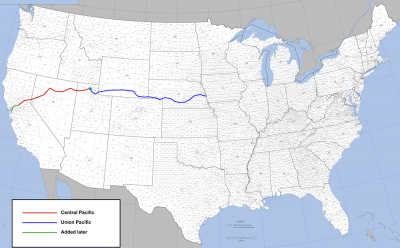North America's first transcontinental railroad (known originally as the "Pacific Railroad" and later as the "Overland Route") was a 1,911-mile (3,075 km) continuous railroad line constructed between 1863 and 1869 that connected the existing eastern U.S. rail network at Council Bluffs, Iowa with the Pacific coast at the Oakland Long Wharf on San Francisco Bay. The rail line was built by three private companies over public lands provided by extensive US land grants. Building was financed by both state and US government subsidy bonds as well as by company issued mortgage bonds. The Western Pacific Railroad Company built 132 miles (212 km) of track from the road's western terminus at Alameda/Oakland to Sacramento, California. The Central Pacific Railroad Company of California (CPRR) constructed 690 miles (1,110 km) east from Sacramento to Promontory Summit, Utah Territory. The Union Pacific Railroad (UPRR) built 1,085 miles (1,746 km) from the road's eastern terminus at the Missouri River settlements of Council Bluffs and Omaha, Nebraska westward to Promontory Summit.The railroad opened for through traffic between Sacramento and Omaha on May 10, 1869, when CPRR President Leland Stanford ceremonially tapped the gold "Last Spike" (later often referred to as the "Golden Spike") with a silver hammer at Promontory Summit. In the following six months, the last leg from Sacramento to San Francisco Bay was completed. The resulting coast-to-coast railroad connection revolutionized the settlement and economy of the American West. It brought the western states and territories into alignment with the northern Union states and made transporting passengers and goods coast-to-coast considerably quicker, safer and less expensive.
The first transcontinental rail passengers arrived at the Pacific Railroad's original western terminus at the Alameda Terminal on September 6, 1869, where they transferred to the steamer Alameda for transport across the Bay to San Francisco. The road's rail terminus was moved two months later to the Oakland Long Wharf, about a mile to the north, when its expansion was completed and opened for passengers on November 8, 1869. Service between San Francisco and Oakland Pier continued to be provided by ferry.
The CPRR eventually purchased 53 miles (85 km) of UPRR-built grade from Promontory Summit (MP 828) to Ogden, Utah Territory (MP 881), which became the interchange point between trains of the two roads. The transcontinental line became popularly known as the Overland Route after the name of the principal passenger rail service to Chicago that operated over the length of the line until 1962.
The Central Pacific Railroad (CPRR) was a rail company chartered by U.S. Congress in 1862 to build a railroad eastwards from Sacramento, California, to complete the western part of the "First Transcontinental Railroad" in North America. Incorporated in 1861, CPRR ceased operation in 1885 when it was acquired by Southern Pacific Railroad as a leased line.
Following the completion of the Pacific Railroad Surveys in 1855, several national proposals to build a transcontinental railroad failed because of the energy consumed by political disputes over slavery. With the secession of the South in 1861, the modernizers in the Republican Party controlled the US Congress. They passed legislation in 1862 authorizing the central rail route with financing in the form of land grants and government railroad bond, which were all eventually repaid with interest. The government and the railroads both shared in the increased value of the land grants, which the railroads developed. The construction of the railroad also secured for the government the economical "safe and speedy transportation of the mails, troops, munitions of war, and public stores."

1869Apr, 28
Chinese and Irish laborers for the Central Pacific Railroad working on the First Transcontinental Railroad lay ten miles of track in one day, a feat which has never been matched.
Choose Another Date
Events on 1869
- 6Mar
Periodic table
Dmitri Mendeleev presents the first periodic table to the Russian Chemical Society. - 28Apr
First Transcontinental Railroad
Chinese and Irish laborers for the Central Pacific Railroad working on the First Transcontinental Railroad lay ten miles of track in one day, a feat which has never been matched. - 15May
Susan B. Anthony
Women's suffrage: In New York, Susan B. Anthony and Elizabeth Cady Stanton form the National Woman Suffrage Association. - 17Nov
Suez Canal
In Egypt, the Suez Canal, linking the Mediterranean Sea with the Red Sea, is inaugurated. - 22Nov
Clipper
In Dumbarton, Scotland, the clipper Cutty Sark is launched and is one of the last clippers ever built, and the only one still surviving today.

 English
English  español
español  français
français  português
português  русский
русский  العربية
العربية  简体中文
简体中文 